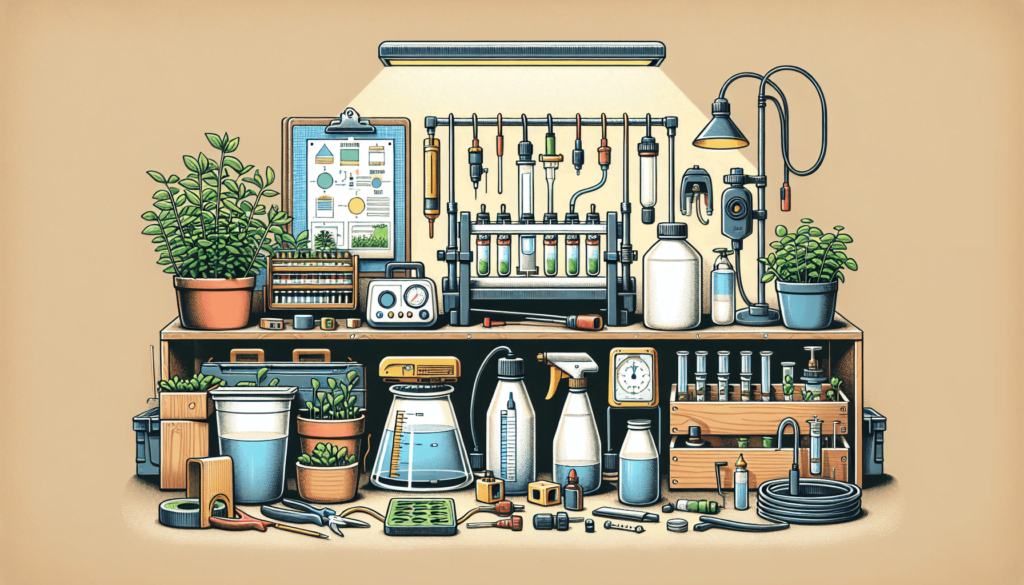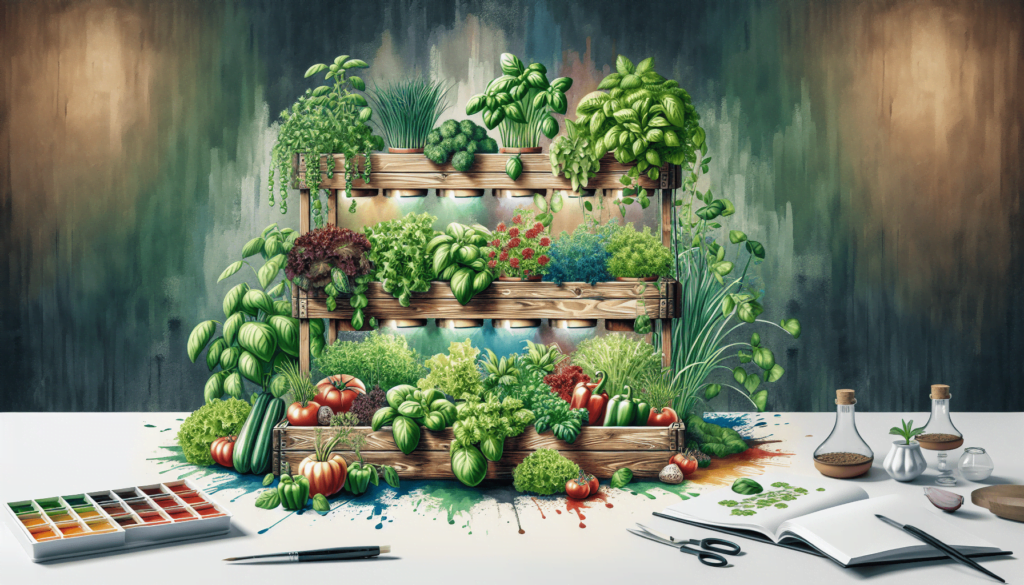Exciting advancements in gardening technology have unlocked the incredible possibility of cultivating lush and nutritious vegetables right in the comfort of home. Imagine the joy of plucking ripe, fresh tomatoes or crunchy lettuce leaves not from an outside garden, but from a flourishing indoor setting. In this guide, an explanation is given on the top methods for indoor hydroponics – a soil-less system where plants are grown in nutrient-rich water. This practice has turned dreamy visions of year-round vegetable gardening into practical reality for many, providing a reliable source of homegrown food and the pleasure of indoor gardening.

Understanding Hydroponics
Hydroponics, in simple terms, is a method of cultivating plants without the use of soil. Instead, the plants are grown in a nutrient-rich water solution. This method allows plants to bypass the soil medium, giving them direct access to vital nutrients.
Definition of Hydroponics
Hydroponics is a subsector of hydroculture and is a method of growing plants using mineral nutrient solutions, in water, without soil. Hydroponic systems support plant growth and provide the necessary nutrients directly into the plant’s root system. It’s a method that can be used all over the world, in any climate, or season.
History and Development of Hydroponics
The history of hydroponics goes far back in time. It was used in the ancient civilisations of Babylon, Egypt, and the Aztecs, where they utilized aqueducts and other waterways to provide water to their crops. The techniques and methodologies have evolved considerably since these early civilizations, and today, hydroponics is a popular and efficient method of horticulture.
Advantages of Hydroponics
Hydroponics offers many advantages over traditional soil-based farming. Firstly, it requires less space as plants can be grown closer together, which is a massive boon for urban areas where space may be limited. Secondly, it utilises water more efficiently, as any unused water can be recirculated within the system. Hydroponics also allows for precise control over the nutrients the plants receive, resulting in faster growth and higher yields.
Challenges Faced in Hydroponics
Despite its many benefits, there are some challenges associated with hydroponics farming. Initial setup costs can be high, particularly for large-scale systems. It also requires a constant supply of water and electricity, which can increase operational costs. Furthermore, because the system is so interconnected, a disease or pest infestation can spread quickly and have disastrous effects.
Choosing the Right Hydroponic System
The success of your indoor hydroponic garden largely depends on the type of system you use.
Various Types of Hydroponic Systems
There are many types of hydroponic systems, including Wick Systems, Water Culture Systems, Ebb and Flow Systems, Nutrient Film Technique (NFT), Aeroponic Systems, and Drip Systems. Each of these systems has its unique characteristics and is suitable for different types of plants.
Factors to Consider When Choosing a Hydroponic System
When choosing a hydroponic system, there are several factors to consider. These include the type of plants you plan to grow, the available space, your budget, and your experience level. While some systems may be better suited to certain types of plants, others may be more adaptable or cost-effective.
How to Set Up a Hydroponic System
Setting up a hydroponic system can be as simple or as complex as you want it to be. First, you need to choose your system type and purchase the necessary equipment. Then, set up your system, ensuring it has access to enough light and the correct temperature. Finally, add your plants and start monitoring their growth regularly.
Choosing the Right Vegetables to Grow
Choosing the right vegetables to grow in your hydroponic system is critical for a successful harvest.
Types of Vegetables Suitable for Hydroponic Farming
Because of the controlled environment, hydroponic systems allow you to grow a variety of vegetables that wouldn’t ordinarily thrive in your geographical area. Some of the most popular vegetables to grow in hydroponic systems include lettuce, tomatoes, spinach, peppers, cucumbers, and herbs.
Considering Factors Such as Growth Rate and Space Requirements
In choosing your plants, you should consider their growth rate and space requirements. Some plants grow quickly but need lots of room, while others might take longer to mature but are more compact. Always ensure that you have available enough space for the full growth of your selected vegetable.
Proper Lighting for Hydroponic Systems
In an indoor hydroponics system, light plays an integral role.
Importance of Proper Lighting
Proper lighting is crucial for hydroponic farming as it significantly affects the quality of the plants. Without enough light, plants will become leggy and weak. On the other hand, too much light can also damage the plants by burning their leaves.
Different Types of Grow Lights
Several types of grow lights are available for use in hydroponic systems. These include incandescent lights, compact fluorescent lights (CFLs), high-intensity discharge (HID) lights, and light-emitting diode (LED) lights.
Choosing the Right Grow Light for your Hydroponic System
Choosing the right grow light largely depends on the size of your hydroponic system, your budget, and the type of plants you are growing. LEDs are more energy-efficient and longer-lasting, although they tend to be more expensive.
Temperature and Humidity Control
Proper temperature and humidity control are fundamental to a successful hydroponic garden.
Ideal Temperature Range for Hydroponic Vegetables
The ideal temperature for hydroponic vegetables is roughly between 65 and 80 degrees Fahrenheit. However, some plants turn out better in cooler temperatures, while others prefer a warmer environment.
Maintaining Optimal Humidity Levels
Maintaining the optimal humidity level is crucial for your hydroponic plants to thrive. If the humidity level is too high, it can lead to the growth of mold and other diseases. If it is too low, it can cause plants to become dehydrated.
Choosing the Right Equipment for Temperature and Humidity Control
The right equipment for temperature and humidity control can help you maintain optimal conditions for your plants. These include heaters and coolers for temperature control and humidifiers or dehumidifiers for humidity control.
Nutrient Solution for Hydroponic Systems
Hydroponic systems rely heavily on nutrient solutions to provide the necessary nourishment for plants.
Understanding the Role of Nutrients in Hydroponic Farming
Without soil to provide nutrients, plants rely entirely on the nutrient solution in hydroponic farming. This solution must contain all of the essential nutrients plants need to thrive, including both macro and micronutrients.
Types of Nutrient Solutions
There are many different types of nutrient solutions for hydroponic systems. These can be premixed solutions or concentrates that you mix with water. They might be synthetic or organic, and they might be specially formulated for different types of plants or growth stages.
How to Mix and Apply Nutrient Solutions
To mix a nutrient solution, you simply add the nutrient concentrate to water according to the package instructions. The nutrient solution is then circulated around the plants’ roots, providing them with all of the nutrients they need.
Proper Water Management
Successful hydroponic farming requires proper water management.
Importance of Proper Water Management
In hydroponic farming, water delivers nutrients to the plants and helps regulate temperature. If too much water is used, it can lead to waterlogged roots and poor plant health. Insufficient water, on the other hand, can cause plants to become dehydrated.
Techniques for Managing Water in Hydroponics
Many hydroponic systems recirculate water, making them more water-efficient than traditional farming methods. Managing water involves monitoring and adjusting the pH and nutrient levels, replacing evaporated or consumed water, and preventing buildup of salts and minerals.
Common Water-Related Problems and Solutions
Some typical water-related problems in hydroponics include nutrient deficiencies, waterlogged roots, and imbalances in pH or nutrient levels. These problems can often be corrected by adjusting the nutrient solution, adding oxygen to the water, or flushing the system and starting afresh.
Pest and Disease Control
Like conventional farming, hydroponics is not immune to pests and diseases.
Common Pests and Diseases in Hydroponics
Some common pests that affect hydroponic systems include aphids, whiteflies, and spider mites. Diseases may include root rot and fungal diseases. It’s essential to continually monitor your plants for early signs of these problems.
Effective Ways of Controlling Pests and Diseases
Hydroponic growers have several options for controlling pests and diseases, including biological controls like beneficial insects, physical controls like traps and barriers, and chemical controls like insecticides and fungicides.
Organic and Chemical Pest Control Methods
Both organic and chemical methods can be effective for pest and disease control in hydroponics. While chemical pesticides might be more potent, organic methods are often preferred due to their minimal impact on the environment and human health.
Harvesting and Storing your Hydroponic Vegetables
Once your plants have fully developed, it’s time to harvest your crops.
When and How to Harvest Your Vegetables
Knowing when to harvest your plants is crucial for maximizing yield and quality. This primarily depends on the type of vegetables you’re growing. Some vegetables can be harvested in sections, while others must be picked in whole.
Storage and Preservation Techniques
After harvesting your vegetables, proper storage is key to ensure the freshness and quality of your produce. Depending on the type of vegetable, they might need to be stored in a cool, dark place or refrigerated.
Utilizing Your Harvest for Personal or Commercial Purposes
Whether you use your hydroponic vegetables for personal consumption or sell them for a profit, you’ll surely appreciate the freshness, quality, and taste of your harvest. Plus, you get the satisfaction of knowing all the hard work you’ve put into the process.
Frequently Asked Questions About Hydroponic Farming
Hydroponic farming is an exciting and rewarding endeavor, but it can also be complex and challenging.
Addressing some common queries about hydroponic farming
One common query about hydroponic farming is whether it’s organic. As long as growers use organic nutrient solutions and pest controls, it can indeed be organic. There are also questions regarding various equipment, space, and investment needed to set up a hydroponic farm.
Troubleshooting common issues in hydroponics
Common issues in hydroponics include faulty equipment, nutrient imbalances, and pest infestations. If you’re facing a problem in your hydroponic garden, don’t despair! Many issues can be solved with a bit of troubleshooting.
Where to get additional help and resources
Look for local agricultural extension services, hydroponics supply stores, or online communities dedicated to hydroponics. They can be valuable sources of information and support as you navigate this rewarding hobby or livelihood. Remember, every gardener faces challenges, and with patience and perseverance, you can overcome them and grow a prosperous indoor garden. Good luck!
You may find more helpful information from our friend Jessica Tay, by reading her “Hydroponic Gardening: Growing Lettuce with Success“
Forum
Got something to share or a question to ask? Jump in and start a conversation! Whether it’s tips, advice, or just sharing your experiences, we’d love to hear from you. Don’t be shy—your input could inspire or help someone else!- This forum has 1 topic, and was last updated 9 months, 2 weeks ago by .
- Topic
- Voices
- Last Post
- You must be logged in to create new topics.


